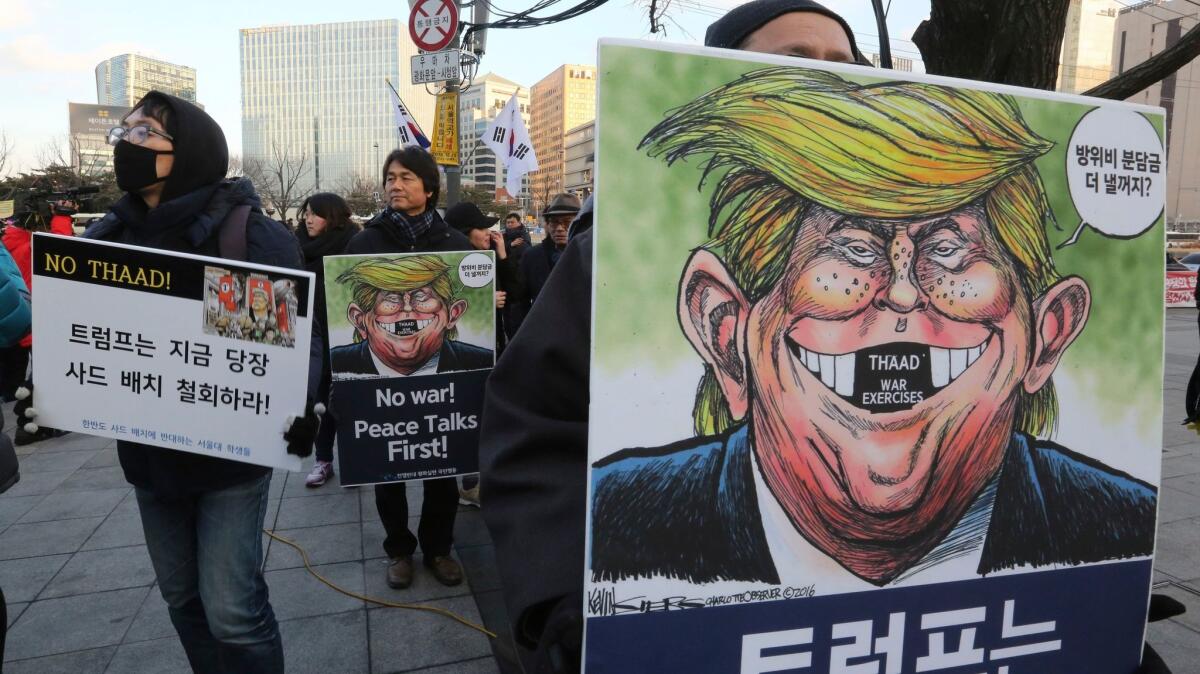Launchers and other parts for U.S. missile defense system arrive in South Korea

- Share via
Reporting from SEOUL — U.S. missile launchers and other equipment needed to set up a controversial missile defense system have arrived in South Korea, the U.S. and South Korean militaries said Tuesday, a day after North Korea test-launched four ballistic missiles.
The plans to deploy the Terminal High-Altitude Area Defense system, or THAAD, by the end of this year have angered not only North Korea, but also China and Russia, which see the system’s powerful radars as a security threat.
China responded quickly, saying it would take “necessary measures” to protect itself and warning that the U.S. and South Korea should be prepared to bear the consequences.
Washington and Seoul say the system is defensive and not meant to be a threat to Beijing or Moscow.
The U.S. military said in a statement that THAAD is meant to intercept and destroy short- and medium-range ballistic missiles during the last part of their flights.
“Continued provocative actions by North Korea, to include yesterday’s launch of multiple missiles, only confirm the prudence of our alliance decision last year to deploy THAAD to South Korea,” Adm. Harry Harris, head of U.S. Pacific Command, said in the statement.
Some South Korean liberal presidential candidates have said that the security benefits of having THAAD would be curtailed by worsened relations with neighbors China and Russia.
“China firmly opposes the deployment of THAAD,” Chinese Foreign Ministry spokesman Geng Shuang said at a regular briefing Tuesday. “We will definitely be taking necessary measures to safeguard our own security interest. All consequences entailed from that will be borne by the U.S. and [South Korea]. We once again strongly urge the relevant sides to stop the process of deployment and refrain from going further down that wrong path.”
China’s condemnation of South Korean plans to deploy THAAD has triggered protests against the South Korean retail giant Lotte, which agreed to provide one of its golf courses in southern South Korea as the site of THAAD. The South Korean government also raised worries about a reported ban on Chinese tour groups visiting the country.
On Tuesday, China’s Global Times, an outspoken nationalist tabloid published by the ruling Communist Party’s flagship People’s Daily, criticized North Korea over the missiles.
“By firing four missiles at once this time, the military confrontation between Pyongyang, Seoul and Washington escalates a notch,” the paper said. “Noticeably, the Chinese public is angry that Pyongyang’s nuclear program has provided an excuse for Seoul to deploy THAAD.”
An official from South Korea’s Defense Ministry, who didn’t want to be named, citing office rules, said that the equipment that arrived in South Korea included launchers, but didn’t confirm how many.
On Monday, North Korea fired four ballistic missiles in an apparent protest against ongoing U.S.-South Korean military drills that it views as an invasion rehearsal. The missiles flew about 620 miles on average, three of them landing in waters that Japan claims as its exclusive economic zone, according to South Korean and Japanese officials.
The North’s state media on Tuesday said leader Kim Jong Un supervised a ballistic rocket-launching drill, a likely reference to the four launches reported by Seoul and Tokyo.
South Korea’s Joint Chiefs of Staff said that the missiles fired by the North were believed to be “improved versions” of Scud missiles. South Korean experts say North Korea’s extended-range Scuds and midrange Rodong missiles are capable of hitting Japan, including U.S. military bases in Okinawa.
UPDATES:
1:10 a.m., March 7: This article was updated with reaction from China.
This article was originally published at 6:50 p.m., March 6.
More to Read
Sign up for Essential California
The most important California stories and recommendations in your inbox every morning.
You may occasionally receive promotional content from the Los Angeles Times.










